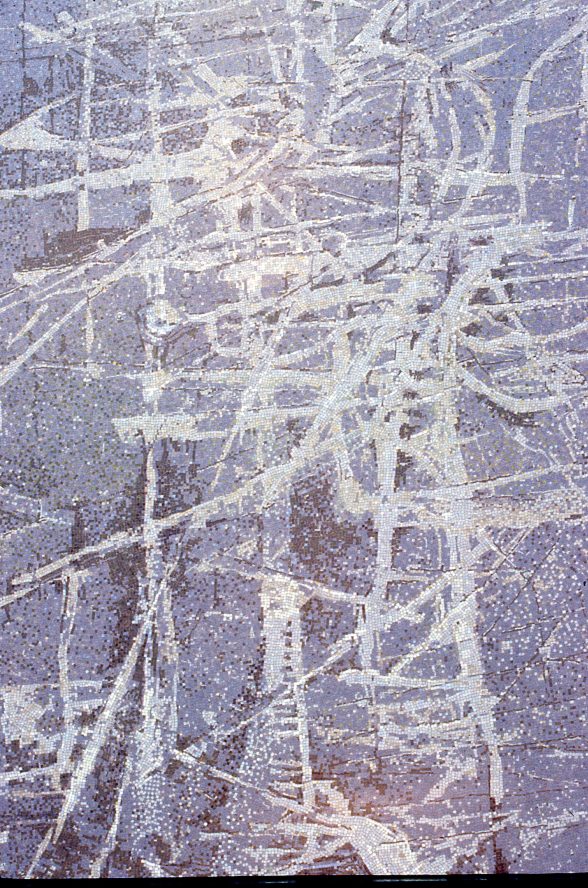This website uses cookies
This website uses cookies to enable it to function properly and to analyse how the website is used. Please click 'Close' to accept and continue using the website.



Photo: Geoffrey Clarke
Plans to remove an important 1950s abstract mosaic from Basildon town centre and relocate it within the entrance lobby of a new residential development are being opposed by the Twentieth Century Society which has submitted an application for it to be listed.
The mosaic, which the society considers to be of ‘outstanding national significance’ is by leading sculptor Geoffrey Clarke, and is mounted on a projection on the second storey of a parade of shops, which are threatened with demolition. C20 wants to see this block saved and listed, highlighting its architectural and historic significance as part of the post-war development of the town centre by the Basildon Development Corporation with the leading 20th-century architect Sir Basil Spence.
Nearly 500 one and two bedroom apartments are planned for the site, arranged in three blocks of up to 17 storeys. The application has been submitted by Orwell (Basildon) Ltd.
Clarke had worked with Basil Spence before on the Cathedral of St Michael in Coventry, which is Grade I listed. Here, he produced the cross, crown of thorns and three stained glass windows between 1957 and 1962. He was then commissioned by Spence to create Spiral Nebula (1962), a sculpture outside the Herschel Building at the University of Newcastle which is Grade II listed.

Photo courtesy Laura Whiting
C20 caseworker Coco Whittaker said: “The mosaic is of special interest as it shows Clarke experimenting with a new medium in the late 1950s. It has been expertly composed and skilfully executed, and it survives in excellent condition. While we are not opposed to its relocation, we would urge that it is not placed in a private atrium but mounted somewhere public in the town centre so it can continue to be enjoyed by everyone, as originally intended. The Society also requests that great care is taken to remove and transport the work to ensure it is not damaged in the process. Regarding the shop buildings, we would like to see them sympathetically upgraded and reused.”
The buildings, Nos. 2-76, were completed in 1958 and formed part of the town centre’s first shopping block. Constructed with a concrete frame and extensive glazing, it is believed it was designed by architect Lionel H. Frewster & Partners and the developer was Ravenseft Properties Ltd. Frewster had worked previously with the Ravenseft on projects at other towns as part of post-war rebuilding efforts.
Basildon was designated a New Town in January 1949, following the New Towns Act of 1946. 28 New Towns were designated under the 1946 Act and 14 were created in England and Wales between 1947-1950, often called Mark One or first generation New Towns.
The town was planned and built by the Basildon Development Corporation: the chief architect was Noel Tweddell; the deputy chief architect Anthony B. Davies; John N. Graham was the senior architect; and Sir Basil Spence served as a consultant. The plan for Basildon was submitted and approved in 1951 and minor modifications were made in 1955. An Architects’ Journal article of 1957 outlines the Corporation’s objective: “to create a self-contained town with medium density, residential areas, industry, shopping, schools, administrative and recreational buildings; and the requisite amount of open space.”
As at Harlow, public art was an important part of the design of Basildon New Town. Early public art commissions included a wall-mounted sculpture by A. J. Poole, a fountain by Maurice Lambert, and ceramic and mosaic murals by William Gordon and Antony Hollaway. Sadly, the Gordon and Holloway art is no longer on display.
Laura Whiting, local resident with an active interest in the architectural history of the town, commented: “As one of the last remaining original public artworks, it’s tremendously important that it remains accessible for all to enjoy and to keep the origin story of the town alive.”
Clarke’s untitled mosaic in Basildon was created in 1958 when the shops were completed. It is subtly curved and has been described by Clarke expert Dr Judith LeGrove as “a beautiful abstract design, in which light—light against dark—feathered and branched.” The composition was established in a painting and translated into a mosaic by Clarke’s wife, Ethelwynne Tyrer (known as Bill) who pieced it together.
Born in Darley Dale, Derbyshire, Clarke studied at various northern art schools and then served in the RAF. In 1948, he entered the Royal College of Art in London, where he became the first to be awarded a silver medal for a first year project, a stained glass work. Clarke represented the Royal College of Art at the Festival of Britain in 1951 and he exhibited in the British Pavilion at the Venice Biennale in 1952. Clarke was one of a group of artists exhibiting in 1952, which included Lynn Chadwick, William Turnbull, Reg Butler, Kenneth Armitage. Their work was characterised by spiky, tortured, organic forms and was described by the art critic Herbert Read as expressing “the geometry of fear”.
He worked on a number of commissions in the 1950s and 60s — “So busy was Clarke”, reports the Guardian in his obituary, “that he was rumoured to travel between projects by helicopter.” Clarke became a Royal Academician in 1975. His work is today held in major galleries, including the Tate and Victoria & Albert Museum
Basildon town centre, with its important works of art and its new town architecture, was proposed as a conservation area by the Society in a Historic England funded research project which sought to identify the 50 most important undesignated areas of twentieth century heritage that deserve conservation areas status. C20 has criticised the council in the past for under estimating the importance of the architectural heritage of the town.

Become a C20 member today and help save our modern design heritage.